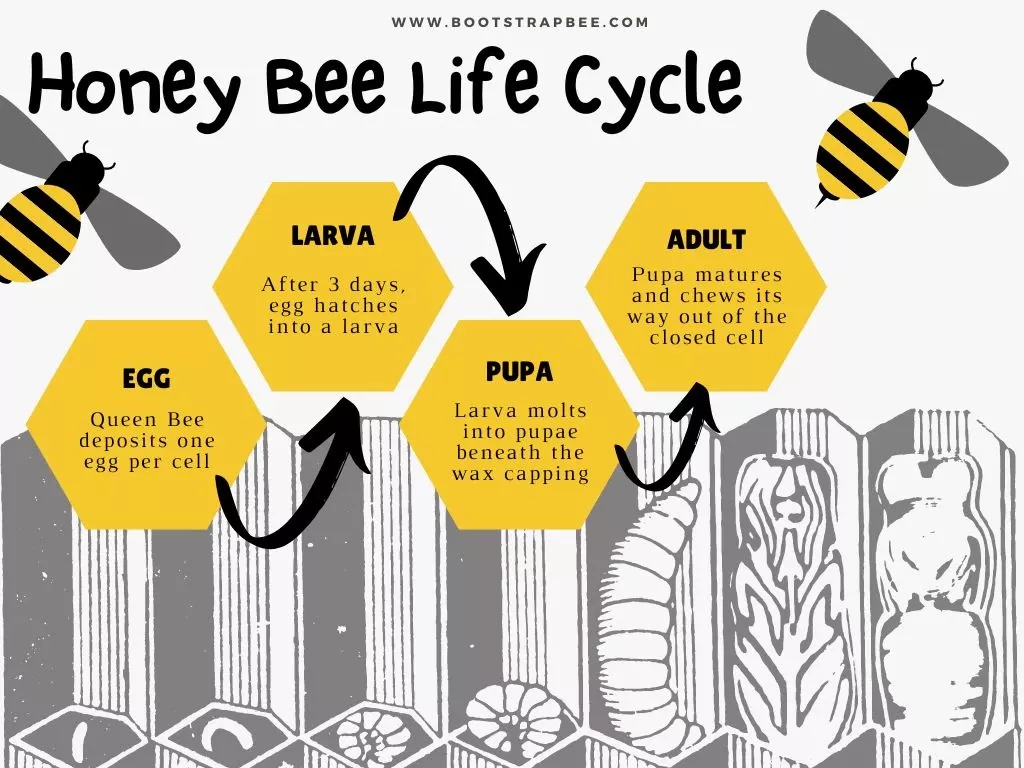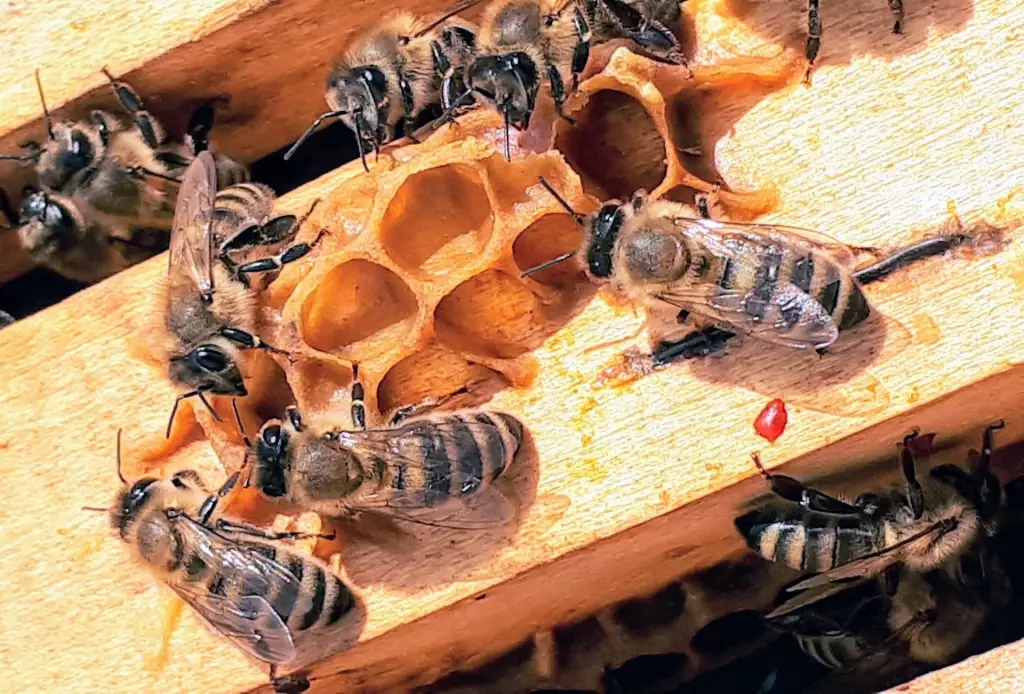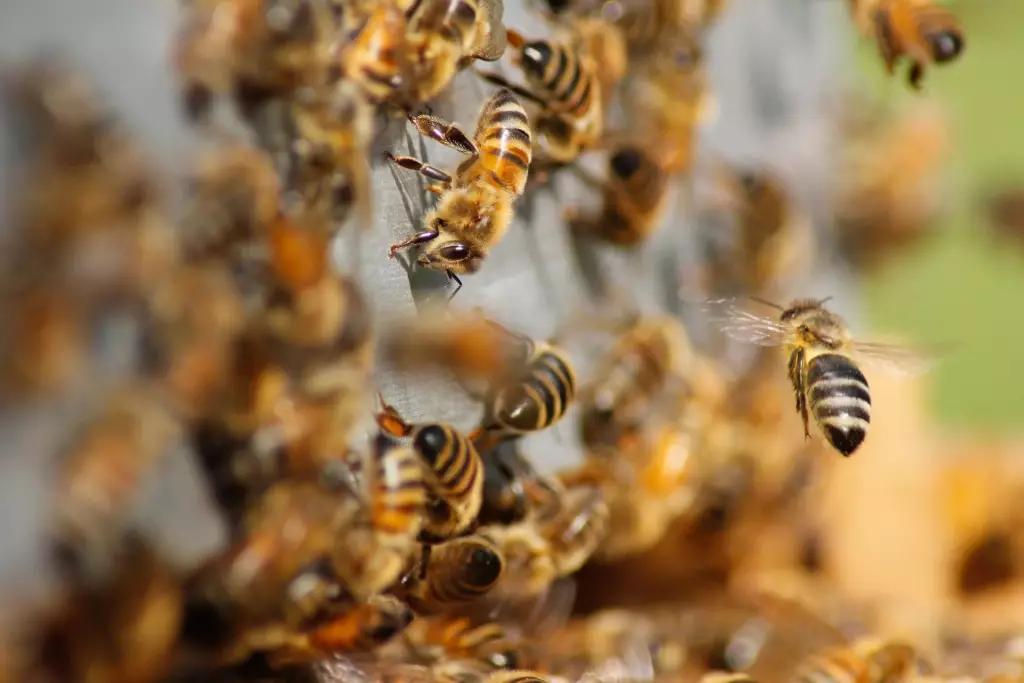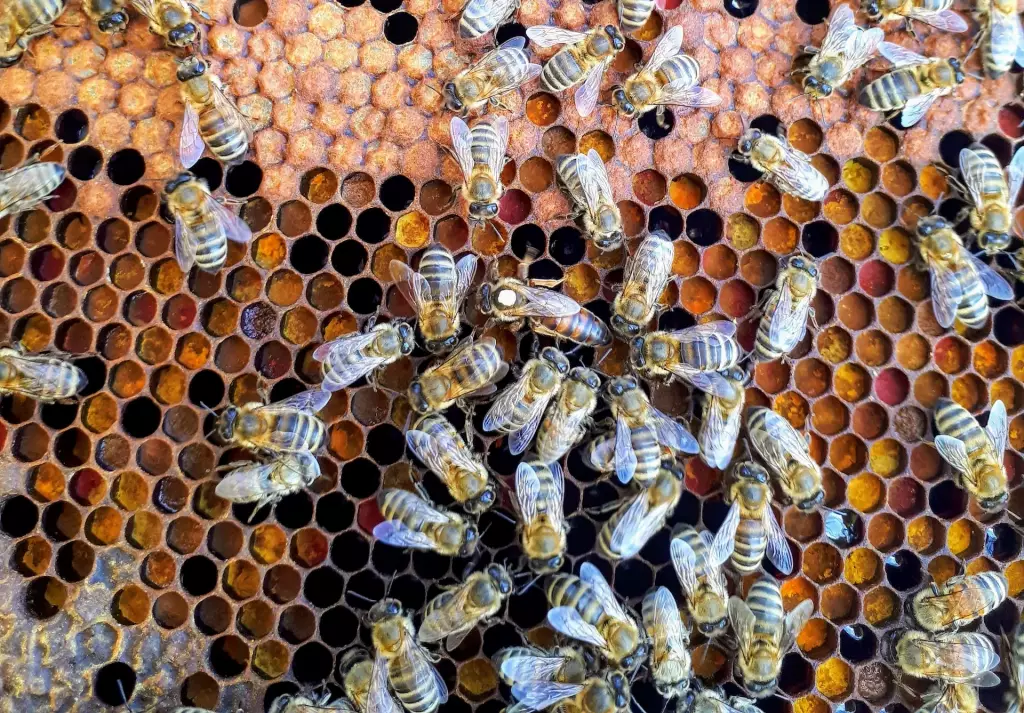Detailed Look at the Honey Bee Life Cycle (w/ Diagram)
Wonder what the entire life cycle of the queen bee, worker bees, and drones looks like? In detail, we’ll discuss their life stages, the days per stage, and the variables that affect them. Here’s a detailed look at the honey bee life cycle.
All honey bees undergo complete metamorphosis or holometabolism. The four distinct developmental stages of a honey bee's life cycle are egg, larva, pupa, and adult. For all three forms of honeybees, eggs hatch in three days and then develop into larvae. The average time from egg to adult varies by caste.
Honey bees are one of the few insects with a social structure, a caste, consisting of a single reproductive queen, drones, and worker bees, or non-reproductive female bees. Bees are social insects because they live in colonies. Their colonies are considered superorganisms, meaning the entire colony, rather than individual bees, is regarded as the biological unit. With this in mind, honey bees reproduce by producing more colonies rather than more individual bees.
Summary
- The queen bee can lay up to 2,000 eggs per day throughout her entire life.
- Humans cannot distinguish between fertilized and unfertilized eggs, but the bees can.
- An adult honey bee's body is divided into three regions: the head, thorax, and abdomen.
- Female worker bees make up the vast majority of adult honey bees in any colony.
- Drones make up only about five percent of the hive population.

The Egg Stage
Bees begin their lives as tiny white eggs. The eggs that a queen bee lays can reach about 2,000 per day in her entire lifetime.
The queen deposits one egg per cell. The eggs measure 1 to 1.5 mm long and look like a tiny grain of rice. They stand upright in individual hexagonal wax cells in the brood area of the comb. They are very difficult to see.
We cannot distinguish between fertilized and unfertilized eggs, but bees can. If the queen makes a mistake, worker bees remove and destroy the egg. The egg development stage lasts only three days.
The worker bees will have built appropriate cells where the queen can lay her eggs.
In most of the cells, the queen bee lays a fertilized egg that develops into female bees, or worker bees.
In cells that are slightly larger than the worker cells, the unfertilized egg hatches, producing drones or male bees.
The Larval Stage
When an egg hatches after three days, it becomes a larva, or a worm-like form.
The larva is a legless and featureless white grub that resembles a tiny white sausage in the shape of a curled “C” at the bottom of its wax cell. A larval group is a collection of larvae.
The larva’s function is to eat and never leave the individual wax cell. A larva eats almost constantly and grows quickly. It grows 1,500 times its original size in just five days.
Adult nurse bees visit the larvae 10,000 times or more during their development for inspection, feeding, and eventually capping of the cells. Worker bees bring food and place it in the cell. They do not directly feed the larva.

The worker bees feed the larvae royal jelly for the first few days. After 2.5 to 3 days, the worker and drone larva's diet switches to honey and a mixture of pollen and nectar called beebread, and food is not as abundantly supplied. This is known as progressive provisioning.
The special protein-rich food called “royal jelly” is fed to all bee larvae, both female and male, during their initial three days as larvae. A pool of royal jelly is kept replenished in the bottom of the cell, and the C-shaped larvae simply lie in it.
Later, the royal jelly is fed only to the female larvae, which eventually become queen bees. The larva of the future queen continues its diet of royal jelly.
The length of time a honey bee spends as a larva varies according to caste. The worker lasts about 6 days, the drone lasts 6.5 days and the queen 5.5 days.
Because the cells in this stage are uncapped, larvae are referred to as “open brood”.
The larva sheds skin multiple times throughout this stage.
When mature larvae are ready to shed into pupae, they extend their bodies upright in the cell. The adult workers then tend to the brood to cover the prepupal larvae with beeswax to protect them. This facilitates the transformation of the larvae into pupae.
The larva spins a cocoon around itself.
The Pupal Stage
Frequently termed capped stage, the pupal stage is the physical transition stage between the amorphous larva and the hairy, winged adult.
The pupa doesn't eat or move.
In the pupa stage, the tiny organism hidden under the capping is starting to look like an adult bee.
Here the bee has developed parts like wings, eyes, legs, and little body hairs that physically resemble those of an adult bee.
Prepupal honey bee larvae molt into pupae beneath the wax capping. The pupae remain hidden beneath the wax capping until they molt into adults and chew their way out of the cell.
Pupae are known as “capped brood” because their cells are capped.
The pupal developmental time, like the larval stage, varies by caste. The worker lasts about 12 days, the drone about 14.5 days, and the queen about 8 days.
The Adult Stage
Once the pupa matures, a new adult bee chews its way out of the closed cell. The average time from egg to adult varies by caste.
The queen bee emerges 16 days from the egg stage to become an adult.
The worker bee takes 18 to 22 days to complete development.
Drone bees take 24 days to develop into adult bees.

Adult honey bees have branched hairs on their bodies and are divided into three body regions: head, thorax, and abdomen.
The compound eyes and antennae are the most prominent features of the head.
There are two pairs of wings and three pairs of legs that connect to the thorax.
A constriction of the second abdominal segment results in a slim 'waist.'
The stinger is the most noticeable external feature of the abdomen. Only female honey bees have stingers, which are derived from a modified ovipositor, or a tubular organ through which a female insect deposits eggs.
Female worker bees make up the vast majority of adult honey bees in any colony.
Worker bees are responsible for the following tasks: tending and feeding young bees (larvae), producing honey, making royal jelly and beebread to feed larvae, producing wax, cooling the hive by fanning wings, gathering and storing pollen, nectar, and water, guarding the hive, building, cleaning, and repairing the comb, and feeding and caring for the queen and drones.
The worker honey bee's job on any given day is determined in part by its age.
Adult honey bee foragers typically live for another 30 days after they begin foraging, for a total of 51 days. This is due to the fact that foraging is one of the most dangerous tasks in the colony.
Foragers are exposed to all the dangers of the outside world when they leave the nest. They could be attacked by predators, lose their way home, become engulfed in a windstorm, become victims of environmental diseases or pesticides, or face any number of other dangers.
When worker bees huddle inside the nest for warmth in the winter, they can live for more than six months.
Queen Bee Life Cycle
Queens emerge in 16 days from the egg stage to become adults.
After emerging, the queens fight among themselves until only one remains in the hive.
There should only be one queen in one beehive. The colony's stability is preserved in this manner.

The swarm of worker bees that follows a queen can be used to identify her.
A queen bee is the only reproductive female in the colony during normal circumstances. She is the largest bee in a colony. Her head and thorax are similar in size to those of the worker. But she has a longer and plumper abdomen, and she is slightly larger than a worker bee. Also, she lacks pollen baskets on her legs.
Queen bees have stingers as well, which they use in battles for colony dominance. Consequently, she does not die when she uses it.
The adult queen's sole responsibility is to lay eggs—up to 2,000 per day. The workers feed her, and she never leaves the hive except to mate.
Within the first week or two of emerging from the pupal chamber, the queen will perform a "nuptial flight." The new queen flies out of the hive and begins to produce a perfume-like substance known as a "pheromone," which attracts drones that are in the area.
The queen will mate with up to 20 drones in the air outside the colony. The drones die after mating.
Mating behavior is known as polyandry. It improves colony fitness and survival by increasing genetic diversity within the colony. Genetically diverse colonies have characteristics such as increased population size, foraging activity, and food supplies. These promote the production of new queens and the formation of new colonies.
Once the queen has mated, she returns to the hive to begin laying eggs in beeswax chambers specially constructed by the workers for this purpose. The mated queen begins egg-laying within 3 or 4 days.
Queen honeybees store sperm in a structure called the spermatheca, which allows them to control egg fertilization. And because she can keep the sperm she has collected for her lifetime, she can lay eggs indefinitely.
When a queen becomes old or weak, her production of queen substance (pheromone) slows, and she is generally replaced by a new queen.
Queen bees live for about a year and a half on average, but some have been known to live for up to six years.
While the queen is alive and active, she is constantly cared for by workers acting as attendants.
When a queen dies prematurely and the colony lacks a new queen, some worker bees develop the ability to lay eggs, but because they cannot mate, they produce only drones, and the colony eventually dies.
New queens are also produced in swarming colonies.